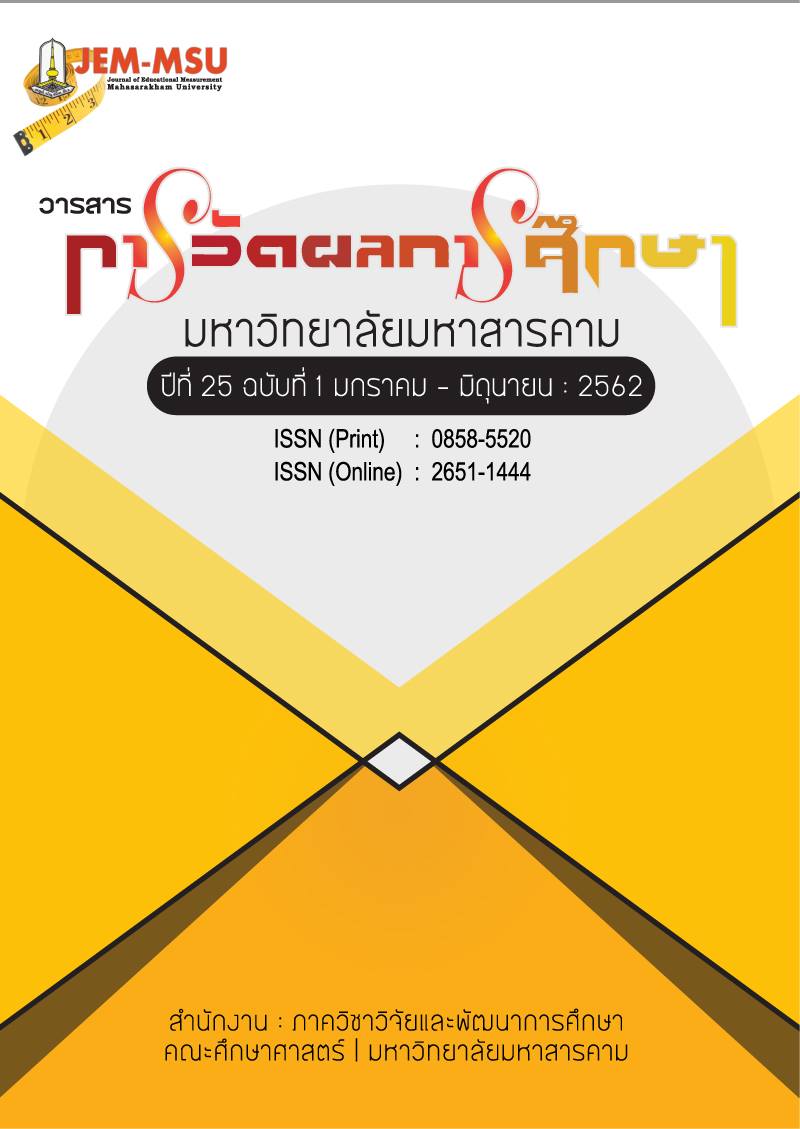Development of a Method of Organizing for Learning to Promote Mathematical Problem Solving Ability of Grade Nine students
Main Article Content
Abstract
The objectives of the research were: 1) to study problems and guidelines on developing mathematical problem solving ability of grade 9 students; 2) to develop a method of organizing for learning to promote mathematical problem solving ability of grade 9 students; 3) to study the results and evaluate the method of organizing for learning to promote mathematical problem solving ability of grade 9 students by: 3.1) comparing mathematical problem solving ability of grade 9 students before and after learning; 3.2) comparing mathematical problem solving ability of grade 9 students, between using the method of organizing for learning to promote mathematical problem solving ability and the normal learning method; 3.3) studying the satisfaction of students with the method of organizing for learning to promote mathematical problem solving ability. The research and development process had 3 stages. The sample consisted of 88 grade 9 students from 2 learning groups of Phonthongpattanawittaya School, Phonthong District, Roi Et Province, in the first semester of the academic year 2017, obtained through cluster random sampling. The research instruments were lesson plans, a mathematical problem solving ability test with the difficulty ranging from 0.34 to 0.73, the discrimination ranging from 0.29 to 0.93, the total reliability of 0.900; and a satisfaction test with the discrimination ranging from 0.490 to 0.775, and the total reliability of 0.931. The statistics used were percentage, the mean, standard deviation, t-test, and content analysis.
The results of the study are as follows:
1. When a student cannot solve mathematical problems, his or her mathematical learning achievement gets low. Some of the ways to solve the problems are: providing various learning activities for students to participate; focusing on solving problems by students themselves; and encouraging students to solve problems in a systematic way, with steps to be followed.
2. The method of organizing for learning to promote mathematical problem solving ability of grade 9 students was based on constructivist theory and the problem solving process of Polya’s. It had 5 steps; reviewing knowledge/introduction, teaching new content, practice, wrap-up, and knowledge applying.
3. The results of using the method of organizing for learning to promote mathematical problem solving ability of grade 9 students were:
3.1 The students who learned by using the method of organizing for learning to promote mathematical problem solving ability of grade 9 students had their scores of mathematical problem solving ability after learning higher than before learning, with statistical significance at the .05 level.
3.2 The students who learned by using the method of organizing for learning to promote mathematical problem solving ability had their mathematical problem solving ability higher than the students who learned by using the normal learning method, with statistical significance at the .05 level.
3.3 The students were satisfied with learning by using the method of organizing for learning to promote mathematical problem solving ability at a highest level.
Article Details
The content and information contained in the published article in the Journal of Educational Measurement Mahasarakham University represent the opinions and responsibilities of the authors directly. The editorial board of the journal is not necessarily in agreement with or responsible for any of the content.
The articles, data, content, images, etc. that have been published in the Journal of Educational Measurement Mahasarakham University are copyrighted by the journal. If any individual or organization wishes to reproduce or perform any actions involving the entirety or any part of the content, they must obtain written permission from the Journal of Educational Measurement Mahasarakham University.
References
กระทรวงศึกษาธิการ. (2551). ตัวชี้วัดและสาระการเรียนรู้แกนกลาง กลุ่มสาระการเรียนรู้คณิตศาสตร์ตามหลักสูตรแกนกลางการศึกษาขั้นพื้นฐาน พ.ศ. 2551. กรุงเทพฯ : ชุมนุมสหกรณ์การเกษตรแห่งประเทศไทยจำกัด.
จิตรา แก้วชัย. (2553). การศึกษาทักษะการแก้โจทย์ปัญหาเรื่องโจทย์ปัญหาร้อยละ สำหรับนักเรียนชั้นประถมศึกษาปีที่ 6 ที่ใช้รูปแบบการสอนตามแนวคิดทฤษฎีคอนสตรัคติวิสต์ โดยเน้นขั้นตอนการแก้ปัญหาของโพลยา. วิทยานิพนธ์ศึกษาศาสตรมหาบัณฑิตมหาวิทยาลัยขอนแก่น.
ทรงศักดิ์ ภูสีอ่อน. (2554). การประยุกต์ใช้ SPSS วิเคราะห์ข้อมูลงานวิจัย. พิมพ์ครั้งที่ 5. มหาสารคาม : สำนักพิมพ์มหาวิทยาลัยมหาสารคาม.
บุญชม ศรีสะอาด. (2545). การวิจัยเบื้องต้น. พิมพ์ครั้งที่ 7. กรุงเทพฯ : สุวิรียาสาส์น.
ปานจิต วัชระรังสี. (2548). การพัฒนาความสามารถในการแก้โจทย์ปัญหาของนักเรียนชั้นประถมศึกษาปีที่ 6 ที่จัดการเรียนรู้แบบร่วมมือกันเทคนิคการแบ่งกลุ่มผลสัมฤทธิ์ร่วมกับกระบวนการแก้ปัญหาของโพลยา. วิทยานิพนธ์ศึกษาศาสตรมหาบัณฑิต มหาวิทยาลัยศิลปากร.
พจนา จิระกาล. (2552). การพัฒนากิจกรรมการแก้ปัญหาคณิตศาสตร์เพื่อเสริมสร้างทักษะกระบวนการทางคณิตศาสตร์ สำหรับนักเรียนชั้นประถมศึกษาปีที่ 4. วิทยานิพนธ์การศึกษามหาบัณฑิต มหาวิทยาลัยทักษิณ.
พิมพ์สรณ์ ตุกเตียน. (2551). ผลการใช้วิธีสอนแก้โจทย์ปัญหาของโพลยาร่วมกับเทคนิคการจัดกลุ่มแบบรายบุคคล (TAI) ต่อความสามารถในการแก้โจทย์ปัญหาทางคณิตศาสตร์ของนักเรียนชั้นประถมศึกษาปีที่ 3. วารสารศึกษาศาสตร์ มหาวิทยาลัยทักษิณ, 9(1), 69-82.
โรงเรียนโพนทองพัฒนาวิทยา. (2557). รายงานผลสัมฤทธิ์ทางการเรียน ปีการศึกษา 2557. ร้อยเอ็ด : โรงเรียนโพนทองพัฒนาวิทยา.
สถาบันทดสอบทางการศึกษาแห่งชาติ. (2557). รายงานประจำปี 2557. กรุงเทพฯ : สถาบันทดสอบทางการศึกษาแห่งชาติ.
สมนึก ภัททิยธนี. (2551). การวัดผลการศึกษา. พิมพ์ครั้งที่ 6. กาฬสินธุ์ : ประสานการพิมพ์.
สำนักงานเลขาธิการสภาการศึกษา. (2554). คู่มือสร้างความรู้ความเข้าใจแก่ผู้บริหาร ครู และนักเรียนเพื่อเตรียมความพร้อมรองรับการประเมินตามโครงการวิจัยนานาชาติ (PISA และ TIMSS). กรุงเทพฯ : พริกหวานกราฟฟิค.
สุวรรณา จุ้ยทอง. (2553). การออกแบบการเรียนการสอนเพื่อฝึกทักษะการแก้ปัญหาทางคณิตศาสตร์ สำหรับนักเรียนชั้นประถมศึกษาปีที่ 6. วารสารศึกษาศาสตร์, 21(2), 51 – 64
อรวรรณ พรมแก้ว. (2551). การจัดกิจกรรมการเรียนการสอนเพื่อส่งเสริมทักษะกระบวนการแก้ปัญหาและการให้เหตุผลทางคณิตศาสตร์ สำหรับนักเรียนชั้นมัธยมศึกษาปีที่ 2 โรงเรียนสันป่าตองวิทยาคม จังหวัดเชียงใหม่. วิทยานิพนธ์ศึกษาศาสตรมหาบัณฑิต มหาวิทยาลัยเชียงใหม่.
อัมพร ม้าคนอง. (2544). คณิตศาสตร์ : ทักษะและกระบวนการทางคณิตศาสตร์:การพัฒนาเพื่อพัฒนาการ. กรุงเทพฯ : ไทยวัฒนาพานิช.
อารมณ์ จันทร์ลาม. (2550). ผลของการสอนแก้โจทย์ปัญหาเศษส่วนโดยกระบวนการแก้ปัญหาของโพลยาที่มีต่อทักษะการแก้ปัญหาของนักเรียนชั้นประถมศึกษาปีที่ 6. วิทยานิพนธ์การศึกษามหาบัณฑิต มหาวิทยาลัยทักษิณ.
Barbato, Rosemary Ann. (2000). Policy Implications of Cooperative Learning and Attitudes of secondary School Mathematicals Students. Dissertation Abstracts International, 61(06), 2113-A ; December.
Chan, K.S. and F. Shin. (2006). Computer-Assisted Learning for Mathematical Problem Solving. Computer & Edution, 40(2), 140-151.
Galotti, Kathleen M. (2011). Cognitive Developmaent : Infancy Through Adolescence. Thoundsand Oaks : SAGE Publication Inc.
Sayed, A.E. (2000). Effectiveness of Problem Posing Strategies on Prospective Mathematics Teachers’ Problem Solving Performance. Doctor’s Thesis, Oman : College of science Sultan Qaboos University Sultanate of Oman.


